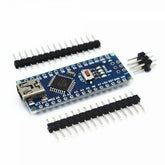Arduino uno vs Nano
Summary
Curious about whether to choose the Arduino Uno or Nano for your next project? Our blog offers a comprehensive comparison to help you decide. Start with an introduction to both the Arduino Uno and Nano, and understand their unique features. Learn about the key differences between these popular boards and explore the various types available for each. Perfect for hobbyists and professionals alike, this guide will help you make an informed choice. Click now to find out which Arduino board best suits your needs!
Introduction to Arduino UNO
The open-source Arduino electronic microcontroller is built on user-friendly hardware and easy to use, It is widely utilized in educational settings to educate robotics, electronics, and programming.
The Arduino uno the perfect tool for exploring Basic Electronics, STEM Education, and programming because of its hands-on nature and simplicity. Arduino is used in many fields, including education and learning, robotics, wearable technology, IoT, art and interactive installations, automated gardening, robotics, robotics, and home automation.

Specifications of Arduino Uno
- Microcontroller: ATmega328P
- Operating Voltage: 5V
- Input Voltage : 7-12V
- Digital I/O Pins: 14 (of which 6 provide PWM output)
- Analog Input Pins: 6
- Flash Memory: 32 KB (ATmega328P) of which 0.5 KB is used by the bootloader
- SRAM: 2 KB (ATmega328P)
- EEPROM: 1 KB (ATmega328P)
- Clock Speed: 16 MHz
- USB Connection: Standard Type B
Get started with the Official Arduino Uno R3.
What is Arduino Nano?
The Arduino Nano comes with 30 male I/O headers in a DIP-30-like configuration. It can be programmed using the Arduino Software integrated development environment (IDE), which is shared by all Arduino boards and can be used both online and offline. The board can be powered via a type-B mini-USB cable or a 9V battery.

Specifications of Arduino Nano
- Microcontroller: ATmega328P
- Operating Voltage: 5V
- Input Voltage : 7-12V
- Digital I/O Pins: 14 (of which 6 provide PWM output)
- Analog Input Pins: 8
- Flash Memory: 32 KB (ATmega328P) of which 2 KB is used by the bootloader
- SRAM: 2 KB (ATmega328P)
- EEPROM: 1 KB (ATmega328P)
- Clock Speed: 16 MHz
- USB Connection: Mini-B USB
What is Arduino Nano? Get the full breakdown!
Differences between Arduino Uno and Nano

Size and Form Factor
The Uno measures 68.6 mm by 53.4 mm, while the Nano is 45 mm by 18 mm. This difference in size can play a crucial role while selecting a board for your project. If your project has limited space, the Nano is likely the better choice.
Power Supply
Both boards operate at 5V, but they differ in how they can be powered. The Uno has a standard barrel jack for power input, allowing for a range of power supply options (7-12V recommended). The Nano, on the other hand, has a mini-USB port for power, and it also can be powered via the Vin pin or a regulated 5V supply connected directly to the 5V pin.
USB Connectivity
The Uno uses a standard Type B USB connector, which is more robust and easier to connect for beginners. The Nano uses a Mini-B USB connector, which is smaller and can save space in compact projects. However, the Mini-B connector can be more delicate and may require more careful handling.
I/O Pins
Both the Uno and Nano have 14 digital I/O pins, with 6 providing PWM output. However, the Nano has 8 analog input pins compared to the Uno's 6. This additional analog input capability can be beneficial for projects requiring multiple sensors.
Programming and Libraries
They both can be programmed by Arduino IDE as they use the same processor. This compatibility ensures that code written for the making it easy to switch between the two.
Memory and Processing
Both boards have Flash memory of (32 KB), SRAM (2 KB), and EEPROM (1 KB). They also operate at the same clock speed of 16 MHz. This means that in terms of processing power and memory, both boards are essentially identical
Cost
The Arduino Nano is slightly cheaper than the Arduino Uno. This price difference can be an important consideration for projects that require multiple boards or are on a budget
Types of Arduino Uno
- Arduino Uno R3
- Arduino Uno WiFi Rev2
- Arduino Uno SMD
- Arduino Uno Mini Limited Edition
Type of Arduino nano
- Arduino Nano
- Arduino Nano Every
- Arduino Nano 33 IoT
- Arduino Nano 33 BLE
- Arduino Nano 33 BLE Sense
- Arduino Nano 33 IoT Sense
Conclusion
Because of their distinct advantages, the Arduino Uno and Arduino Nano can be used for a variety of applications. Because of its bigger size, sturdy connections, and ability to work with different shields, the Uno is a great choice for beginners reliable prototyping.
The Nano's small size allows for greater design flexibility and is ideal for applications with limited area. between the two, it depends on the requirements of your project, such as size restrictions, power limitations, and the demand for shield usage, before choosing between the two.
It will assist you in making an informed choice if you are aware of the advantages and disadvantages of each board. In the end, the Arduino Uno and Nano both offer the capabilities and adaptability that make Arduino a programming tool.














